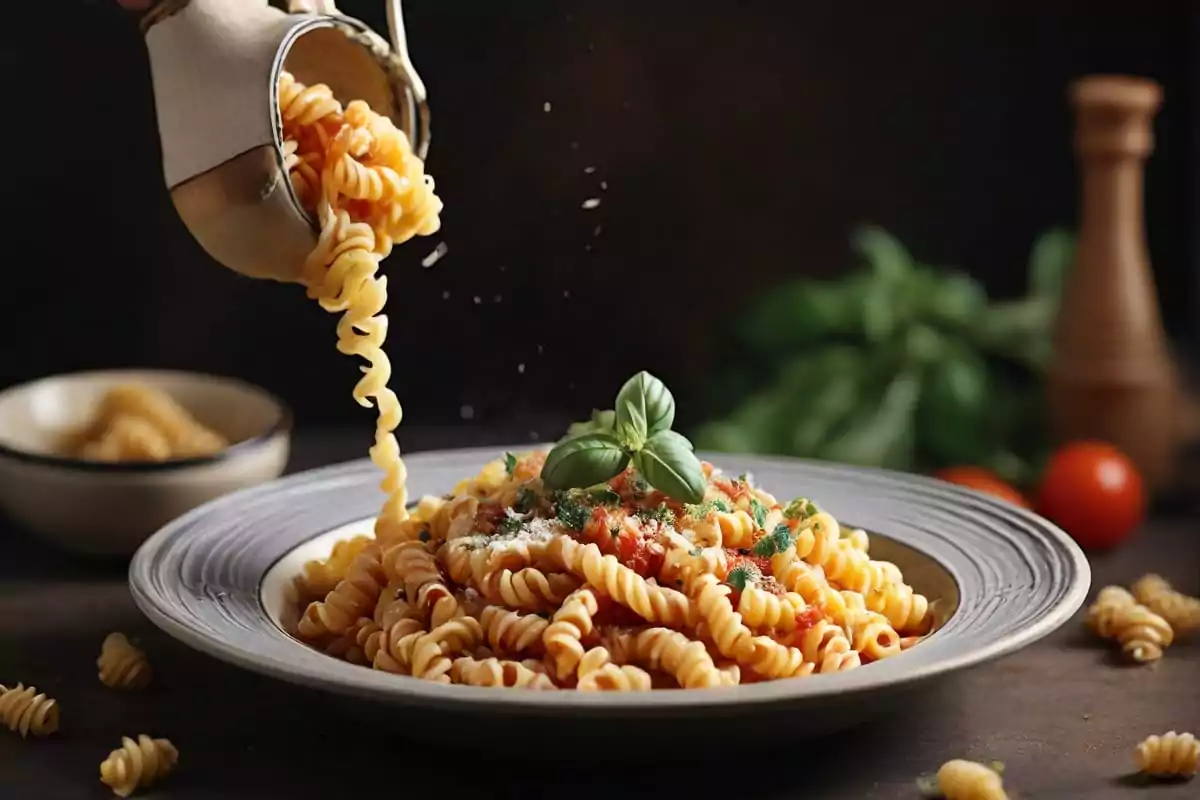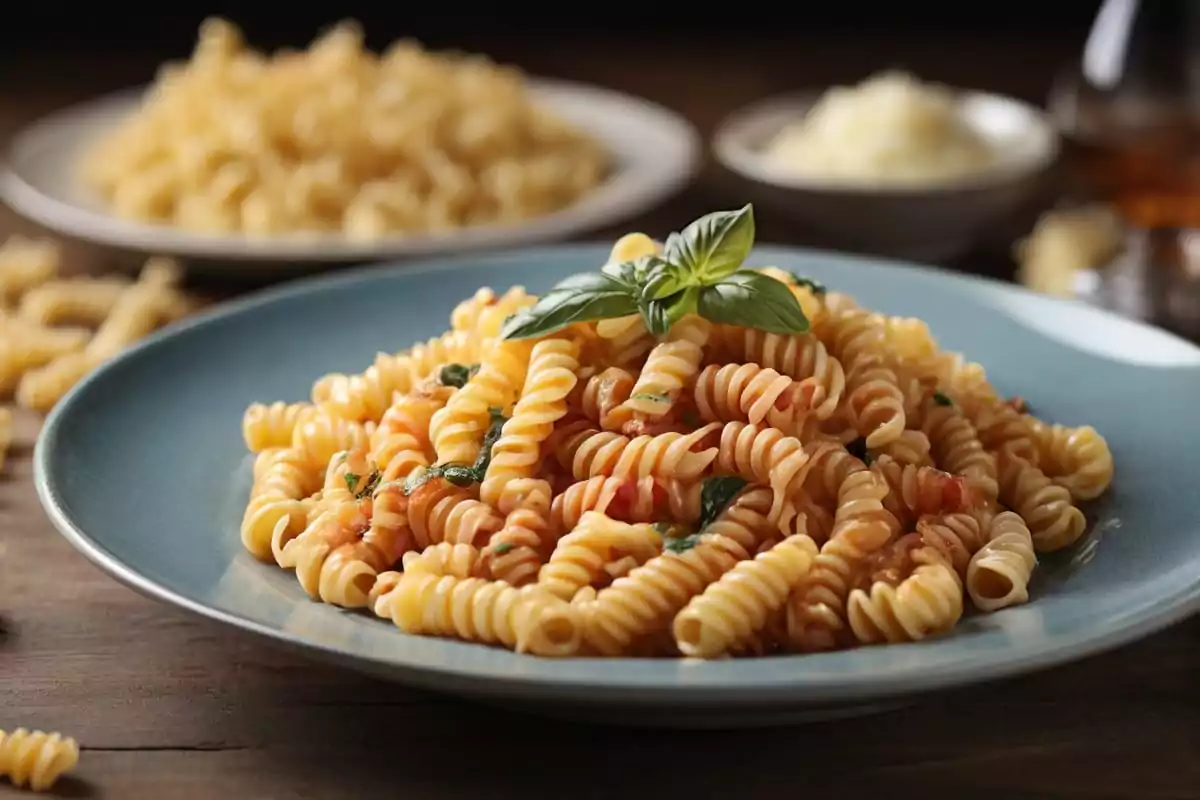Introduction to Fusilli Pasta
Understanding Fusilli
Fusilli Pasta. This coiled marvel captivates us. Its playful spirals and sauce-grabbing ability make it a standout. What’s the secret? The shape. Twirling your fork through these spirals is pure joy. Each bite is a perfect mix of pasta and sauce.
Fusilli’s origins are as twisted as its shape, deeply rooted in Italian tradition. Artisans once crafted it by hand, spinning dough around a rod. This method filled each piece with homemade love, making fusilli a cherished Italian staple.
Historical Background of Fusilli
Fusilli traces back to Italy, intertwining with Italian cuisine’s evolution. It’s evolved from a simple need for a sauce-capturing pasta to a beloved ingredient worldwide. Each Italian region has its fusilli version, showing Italian cuisine’s diversity and creativity.
In pasta’s grand tapestry, fusilli holds a special place. It embodies the joy and artistry of Italian cooking. As we explore fusilli, we’ll uncover its popularity secrets. Let’s twirl our way through fusilli’s fascinating story with our forks ready.
Types of Fusilli
Exploring the Varieties of Fusilli
Dive into the world of fusilli, and you’ll find it’s not just a single shape but a family of twists and turns. Each type brings its own texture and sauce-pairing abilities to the table. Let’s twirl through the main varieties.
Fusilli Corti Bucati
First up, Fusilli Corti Bucati. This version is like the classic fusilli but with a twist—literally. It features short, hollow centers, making it a playful yet sophisticated choice. Its design is perfect for thicker sauces. The hollow center and external spirals trap and hold onto every flavorful drop.
Fusilli Lunghi
Then, there’s Fusilli Lunghi. Imagine the spirals of fusilli stretched into longer strands. This type offers a delightful texture contrast, combining the twirlability of spaghetti with the sauce-catching prowess of fusilli. It’s a match made in heaven for lighter, olive oil-based sauces.
Fusilli Col Buco
Lastly, we have Fusilli Col Buco. This variety takes the hollow center of Fusilli Corti Bucati and extends it into a longer, more pronounced spiral. It’s the ultimate twirling pasta, offering a unique mouthfeel and an exceptional ability to mingle with every type of sauce.
The Art of Choosing Fusilli
Choosing the right fusilli type can elevate your dish from good to unforgettable. Consider the sauce and the dining experience you’re aiming for. Want a hearty, comforting meal? Go for Fusilli Corti Bucati with a rich, creamy sauce. Looking for a light, refreshing pasta dish? Fusilli Lunghi with a pesto or olive oil-based sauce might be your best bet.
In the end, each fusilli variety offers a unique way to enjoy your favorite sauces and ingredients. By understanding the nuances of each type, you can tailor your pasta dishes to suit any occasion, taste, and texture preference. So next time you’re in the pasta aisle, think beyond the shape. Consider the endless possibilities that each fusilli variety brings to your table.

Making Fusilli Pasta
How Fusilli is Made
The magic of fusilli begins with its creation. Whether through traditional handcrafting or modern production, the process is a fascinating blend of art and science.
Traditional Methods
Traditionally, making fusilli was a hands-on affair. Artisans would take a small rod or wire and wrap the dough around it, manually rolling it to create those iconic spirals. This method required skill and patience, as each piece needed to be uniform to ensure even cooking. The result? A pasta that carried not just the flavors of the sauce it would later embrace but also the touch of the maker’s hand. This personal touch added a special dimension to the pasta, making it a favorite in homemade Italian dishes.
Modern Production Techniques
Today, while the essence of fusilli remains, technology has streamlined its production. High-tech pasta machines extrude dough through molds to achieve the perfect spiral shape. This method allows for a consistent and uniform shape, essential for commercial distribution. Yet, even with modern techniques, the goal remains the same: to create a pasta that’s as delightful to eat as it is effective in capturing every nuance of sauce it’s paired with.
The Craftsmanship Behind Fusilli
The transition from handcrafted to machine-made fusilli highlights the pasta’s evolution while maintaining its culinary integrity. Each method, whether old or new, showcases a dedication to creating a product that enhances the dining experience. The craftsmanship behind fusilli is a testament to the pasta’s enduring appeal, blending tradition with innovation to meet the tastes of pasta lovers around the world.
In essence, the creation of fusilli is a beautiful process that marries tradition with technology. Whether twirled by hand or machine, the spirals of fusilli continue to capture the hearts (and palates) of those who seek a pasta that truly embraces every drop of sauce. As we explore the culinary uses of fusilli, it’s this craftsmanship that we celebrate—a dedication to deliciousness that makes every forkful a joy.
Cooking with Fusilli
Culinary Uses of Fusilli
Fusilli, with its captivating spirals, is not just a feast for the eyes but a canvas for culinary creativity. Its unique shape and texture make it incredibly versatile, suitable for a wide range of dishes from around the globe.
Ideal Sauces for Fusilli
The spirals of fusilli are perfect for clinging to sauces, making every bite a delightful mix of pasta and flavor. Thick, creamy sauces find their match in fusilli, as the grooves hold onto the sauce, ensuring that no mouthful is bland. For a classic Italian dish, try pairing fusilli with a rich tomato-based sauce or a creamy Alfredo. The pasta’s texture contrasts beautifully with the smoothness of the sauce, creating a dish that’s both comforting and satisfying.
For those who prefer a lighter touch, fusilli also dances well with olive oil-based sauces. A simple aglio e olio, where garlic and olive oil meld together in a symphony of flavors, highlights fusilli’s ability to carry even the most delicate of sauces.
Fusilli in Pasta Salads
Beyond hot dishes, fusilli shines in cold pasta salads. Its spirals can hold onto dressings and mix-ins like vegetables, cheeses, and meats, making every forkful a surprise. Whether you’re aiming for a light, refreshing side or a hearty main, fusilli adds texture and interest to your salad. For a summer picnic or a potluck, a fusilli pasta salad can be a colorful, flavorful standout that’s as easy to make as it is to enjoy.
Creative Recipes Featuring Fusilli
The fun shape of fusilli inspires creativity in the kitchen. From baked pasta dishes, where fusilli captures pockets of cheese and sauce, to innovative stir-fries that give a twist to traditional Asian flavors, the possibilities are endless. For a fusion dish, consider tossing fusilli with pesto and roasted vegetables for a meal that’s both hearty and healthful.
To dive deeper into the culinary world of pasta, consider exploring our comprehensive Fusilli Pasta Guide, which offers a plethora of information and recipes tailored to fusilli enthusiasts. Additionally, for those curious about the subtle differences between similar pasta shapes, our article on Fusilli vs. Rotini Pasta: Differences provides insightful comparisons to enhance your pasta knowledge.
In cooking with fusilli, the only limit is your imagination. Its versatility makes it a staple in the pantry of anyone who loves to explore the art of cooking. Whether you’re whipping up a quick weeknight dinner or preparing a special meal for friends and family, fusilli offers a world of culinary possibilities waiting to be discovered.

Frequently Asked Questions
As we’ve twirled through the world of fusilli, a few questions have popped up more often than others. Let’s dive into some of the most common inquiries about this beloved pasta shape.
What makes fusilli different from other pasta shapes?
Fusilli stands out due to its unique spirals and twists. This shape is not just for show; it serves a purpose. The grooves and coils of fusilli are perfect for capturing and holding onto sauces, making every bite flavorful. Unlike straight pasta shapes that might let sauce slide off, fusilli ensures that each forkful is as delicious as the last.
How do you perfectly cook fusilli?
The key to perfectly cooked fusilli is timing. Start by boiling a large pot of salted water. Once boiling, add the fusilli and stir occasionally to prevent sticking. Follow the package’s recommended cooking time, but always taste a piece a minute or two before the time is up. You’re aiming for al dente—firm to the bite. Once it’s there, drain the pasta but save a cup of the pasta water to help emulsify your sauce.
Can fusilli be used in cold pasta dishes?
Absolutely! Fusilli is incredibly versatile and works wonderfully in cold pasta salads. Its spirals can hold onto dressings and mix-ins like vegetables, cheeses, and meats, making every bite interesting and flavorful. For a refreshing summer dish, toss fusilli with cherry tomatoes, mozzarella, fresh basil, and a drizzle of balsamic glaze.
Navigating the twists and turns of fusilli can be as fun as it is delicious. With its unique shape and ability to pair with a wide range of sauces and ingredients, fusilli is a pasta shape that invites creativity and experimentation. Whether you’re a seasoned chef or a home cook, there’s always something new to discover with fusilli. So, keep these FAQs in mind, but don’t be afraid to explore and create your own signature dishes with this versatile pasta.
LSI and NLP Keywords
Enhancing Your Fusilli Content
When diving into the world of fusilli, incorporating a variety of related terms and concepts can enrich your culinary exploration. Let’s sprinkle in some LSI (Latent Semantic Indexing) and NLP (Natural Language Processing) keywords to spice up our fusilli discourse.
- Pasta Shapes: Understanding the vast array of pasta shapes can enhance your appreciation of fusilli’s unique place in the pasta universe.
- Gluten-Free Fusilli: For those with dietary restrictions, gluten-free options ensure that everyone can enjoy the delights of fusilli.
- Pasta Recipes: A treasure trove of fusilli recipes can transform your meal planning with creative and delicious options.
- Italian Cuisine: Fusilli is a staple in Italian cooking, embodying the tradition and innovation of Italian culinary arts.
- Cooking Pasta: Mastering the art of cooking pasta is essential for achieving the perfect fusilli dish.
- Pasta Salads: Fusilli shines in pasta salads, offering a textural contrast that elevates this dish to a new level.
- Fusilli with Sauce: Pairing fusilli with the right sauce can turn a simple meal into a memorable feast.
Incorporating these keywords into your culinary conversations or writings about fusilli not only broadens the scope of discussion but also enhances the depth of content, making it more engaging and informative for readers or listeners. Whether you’re crafting a blog post, preparing a menu, or simply chatting about your latest culinary creation, these terms can help paint a fuller picture of fusilli’s role in the world of pasta.
By weaving these LSI and NLP keywords into your narrative, you’re not just talking about pasta; you’re inviting your audience on a gastronomic journey that explores the rich tapestry of flavors, textures, and traditions that fusilli represents. So, let these keywords inspire you to delve deeper into the culinary delights of fusilli, and share your discoveries with fellow pasta enthusiasts.
